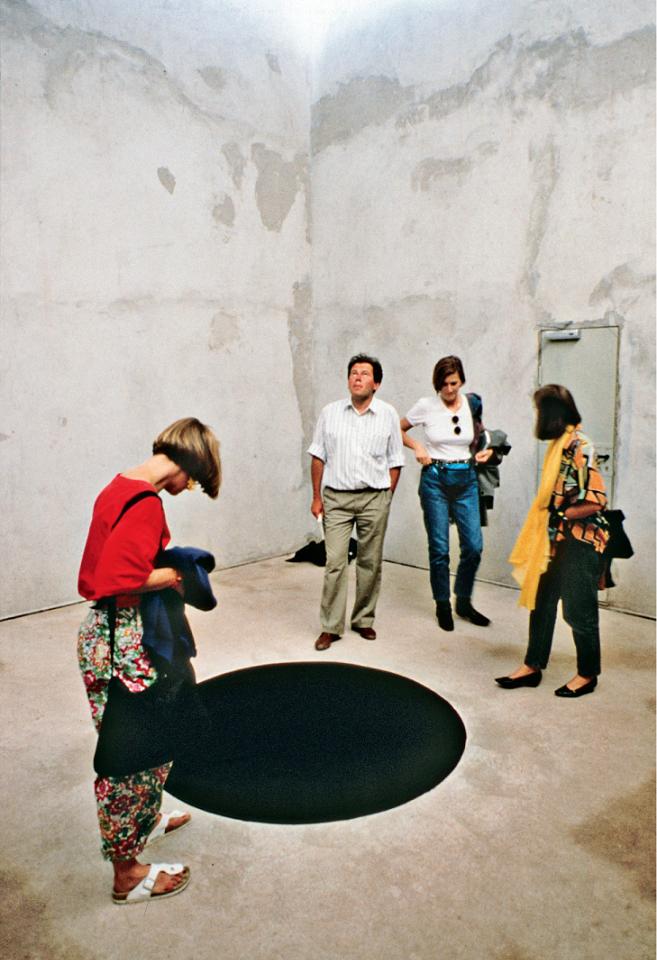
Anish Kapoor (Mumbai, 1954)
Falling into Hell, 1992
Cement, stucco and pigments, 600 cm× 600 cm× 600 cm. Documenta 9th Kassel
Under modern norms, people prefer to find a connection between the present and the past, and hope to be able to study without being affected by the logical connections of historical narratives, and with a sense of distance. At least under different conditions, this approach can provide new perspectives for understanding individual handmade artifacts. People do this to prove that works of art do not exist in a single meaning. Although the number of handmade products is large, there are few interesting interpretations that people make from the perspective of freedom and from the perspective of "postmodernism". Philosophers and psychologists were very careful in interpreting works of art, often refuting foucault and Derrida's ideas, but I think it is necessary to be cautious. I pay high tribute to Lacan Jacques's nuance in his use of words and for Foucault's view of archaeology from the perspective of art history in his famous "archaeological" works. These art historians are accustomed to dealing with very basic documents, such as contracts, wills, restored sticky notes, and gallery inventory. On the other hand, traditional art history standards have not completely lost the market. A collage by Richard Hamilton is not simply taken from Roland Barthes's mythology, but also means that Hamilton was influenced by portraits of the Arnolfinis hanging on the wall of the National Gallery. Before "differentiation" was embraced by the feminist movement, Rebecca Horn walked in the countryside of Hessenian in unicorn-like clothing as a young man, an act she traces back to medieval iconographic traditions.
The evaluation of the art world in recent decades may seem controversial, but it is this that makes the discipline interesting. The problem in the art world today is that art can make people think of many things, but in particular, art is not like anything. We know what art means, but we're not sure what it is. Artistically, it doesn't provide enough information for us to make decisions.
In the course of studying art history, people have envisioned various development prospects of art, different ways of interpreting art, and the various creative methods that artists will choose, which has never been the case. These new approaches to art history are placed on an equal footing with traditional art history methods that are still in use—such as visual linguistics, source material criticism, iconography, and order analysis. Art history's narrative methods have never been more diverse and controversial. Even so, the multitude of possibilities for interpretation makes it all the more necessary for people to use their own point of view and to interpret from their own perspective.
In this book, I start with a basic argument. One can say that for at least 30 years from the mid-1960s onwards, the theme of excellent works of art in Europe and America was the study of the boundaries between art and reality. Art history is once again outside this kind of research. And in the art striving to realize the tradition of formalism and the aesthetics of tradition, one should understand it within the scene constituted in such a formed way. This in fact makes it possible to embody pluralism and freedom of expression.
We are going to use two parabolas to describe and summarize art from 1960 onwards. The first parabola represents the aesthetics of modernism, which Clement Greenberg established as a model and as an organized inheritance and end of the period from Eduard Manet to the New York School, and we intercept its last period. The second ascending parabola, however, represents the "post-historicist" situation of art, which refers to exposing the artist to a wide range of possibilities and the balance between form and material. I was extremely careful in choosing the examples I studied, including some of those born in the 60s, and I was born in this period, a generation that did a lot of important things in the last decade of the 20th century.
Excerpt from Contemporary Art
Global Art History
[Italy] by Alexandre del Popo
Translated by Zhou Binbin
Shanghai Sanlian Bookstore Phoenix Yili
The problem in the art world today is that art can make people think of many things, but in particular, art is not like anything. We know what art means, but we're not sure what it is.
The book is accompanied by exquisite pictures that show the reader the development of modern art.
Synopsis
Contemporary Art is one of the books in the "Global Art History" series. This book introduces readers to the development of contemporary art from the 20th century to the present, taking the rise of a new generation of artists represented by Pollock as the source, selecting iconic events in contemporary art to expound, and revealing the roots of some interesting phenomena unique to contemporary times.
Introduced from Italy, the "Global Art History" series is a new, open and systematic encyclopedia of world art that introduces readers to artistic creations from different periods and countries.
About the Author
Alexander del Popo is a professor at the University of Udine in Italy, a researcher of art history, and the author of several works on art history, including Contemporary Art.
Translator Profile
Zhou Binbin, graduated from Beijing Second Chinese College of Foreign Language and Literature, majoring in Italian Language and Literature. She has translated manuscripts for a number of cooperative units, participated in international level examination projects and obtained excellent results, translating "Art in the Romantic Era", "Art in the Napoleonic Era", "Vatican Tombs" and so on.
| all rights reserved, please do not reprint | without authorization
| if you have copyright related questions, you can contact the background to deal with |
★ Phoenix One Force | creator ★ of the ultimate reading experience